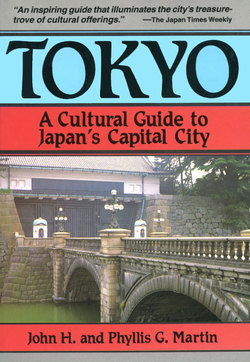Читать книгу Tokyo a Cultural Guide - John H. Martin - Страница 7
На сайте Литреса книга снята с продажи.
ОглавлениеIntroduction
Tokyo and Its Heritage
IN 1590, Tokugawa Ieyasu, the powerful warlord of eastern Japan, was beholden to Toyotomi Hideyoshi, the military ruler over all the nation. Hideyoshi, anxious to remove Ieyasu from Kyoto and the center of political power, offered to exchange certain of Ieyasu's territorial holdings near Kyoto for a grant of extensive lands in the underpopulated area in eastern Japan. Ieyasu's followers were aghast at their leader's acceptance of the isolated land at Edo Bay in exchange for his more valuable lands near the imperial capital. Ieyasu, however, had a vision he had not as yet shared with them. Here at the tiny village of Edo (Mouth of the River or Estuary), where the Sumida and other rivers poured into an almost completely encircled bay at the edge of the great Kanto Plain, he would create a mighty civil capital, and from here he and his heirs would rule all of Japan.
With the passage of time, with patience, with guile—and with force—Ieyasu would bring this vision to reality. By 1598 Hideyoshi was dead, and, in the ensuing struggle among the contesting daimyo, the feudal lords who coveted power, Ieyasu had by 1603 conquered all who stood in his way and now ruled as shogun over all Japan. As victor, Ieyasu moved the seat of civil and military power from an effete aristocratic court in Kyoto to the land at the head of the large and sheltered bay where he would build his capital. Thus Edo, the future Tokyo, began its modern existence. Here as shogun he ruled overJapan in the name of the powerless emperor and over the 176 Inside Lords (Fudai Daimyo) who had sided with him before his decisive and victorious battle at Sekigahara in 1603. He also ruled over the 86 Outside Lords (Tozama Daimyo) who had not been farsighted enough to be his allies.
Ieyasu forced both the inside and the outside daimyo to supply labor, materials, and funds for the construction of an impregnable castle in Edo. The work of creating moats, canals, walls, and a fortified residence went on until 1640. From 1603, and for the next 265 years, Ieyasu's successors as shoguns were to rule the nation with unparalleled control from the Edo Castle.
Both to control and financially to weaken any possible contenders for power, Ieyasu enforced the rule of sankin kotai (alternate attendance) on his vassals. Alternate periods of two years had to be spent by the leaders of the great clans at their Edo residence. Thus the great daimyo made their compulsory biennial passage from their domains to Edo, a progression with all the panoply and display as required by the Tokugawa shoguns. It was an ostentatious progress which would keep them sufficiently impoverished. At the end of the period of attendance on the shogun, their return to their territorial homes took place with the same pomp. One half of the Outside Lords had to make their journey to Edo in March of each year while the other half returned to their homes that month. The Inside Lords made their biennial journey in alternate years in August.
In Edo, custom and honor forced these daimyo to live in splendid mansions befitting their rank. On their return to their domains they had to leave their women and children as hostage in their Edo palaces of Momoyama grandeur as warrant of their good behavior. The expense of maintaining their territorial seat of power and an elaborate establishment in Edo, with the incumbent costly procession between the two locations, financially precluded any attempts on their part to mount a threat by force against the Tokugawas.
As an additional precaution, the Tokugawa shoguns had barriers erected at points along the main highways into Edo, and here the rule of "no women out, no guns in" maintained the hostage system and kept the daimyo weaponless within the new civil capital.
For 265 years the Tokugawas ruled from their mighty Edo Castle, a fortress which only nature and time (but no military attack) would subdue. Its nemesis appeared in the form of earthquakes and fire, and these untoward events occurred on more than one occasion. When in time the rule of the Tokugawas came to an end (1868), Edo was renamed Tokyo (Eastern Capital). Then a sixteen-year-old emperor was moved from Kyoto to reign from the former castle grounds. Ostensibly power had returned from the shogun to the emperor, but time would disclose the powerless nature of imperial rule since the nation's new military leaders were the real power behind the throne and would both enhance and endanger the nation's place in the world. It is one of the ironies of history that in time a blue-eyed "shogun" in the guise of an American general would reign over Japan for a number of years before a new and more democratic form of governance would issue from the political and economic centers about Edo Castle, now become the Imperial Palace of Tokyo.
The walking tours which follow begin at that place from which many visitors arrive at Tokyo: Tokyo Central Station. The walks then spiral out from the palace to encompass the variety that the city has to offer. The subway or rail station from which each walk begins is indicated at the beginning of that walk. Thus with a map of Tokyo (which can be obtained from one's hotel or from the Japan National Tourist Office on Harumi-dori just down from the junction of the Palace and Hibiya Park) and a plan of the Tokyo subway lines, one can venture forth into a fascinating city.
